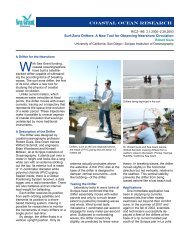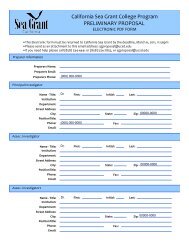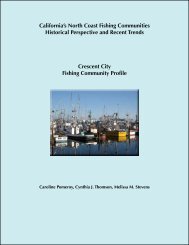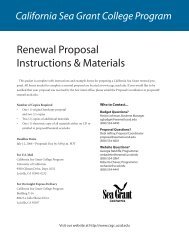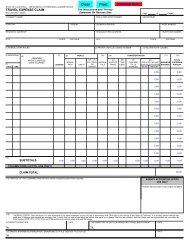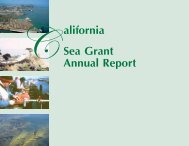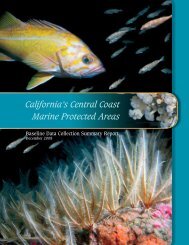PAT-UC Covers - California Sea Grant - UC San Diego
PAT-UC Covers - California Sea Grant - UC San Diego
PAT-UC Covers - California Sea Grant - UC San Diego
Create successful ePaper yourself
Turn your PDF publications into a flip-book with our unique Google optimized e-Paper software.
Appendix G<br />
Producing Significant Results<br />
REPRINTS – JOURNAL ARTICLES, ETC. CONT’D<br />
Beaulieu, S.E., M.M. Mullin, V.T. Tang, S.M. Pyne, A.L. King, and<br />
B.S. Twining. 1999. Using an optical plankton counter<br />
to determine the size distributions of preserved<br />
zooplankton samples. J. Plankton Res. 21(10): 1939-<br />
1956.<br />
Benumof, B.T., and G.B. Griggs. 1999. The dependence of<br />
seacliff erosion rates on cliff material properties and<br />
physical proesses: <strong>San</strong> <strong>Diego</strong> County, <strong>California</strong>. Shore<br />
& Beach 67(4): 29-41.<br />
Benumof, B.T., C.D. Storlazzi, R.J. Seymour, and G.B. Griggs.<br />
2000. The relationship between incident wave energy<br />
and seacliff erosion rates: <strong>San</strong> <strong>Diego</strong> County, <strong>California</strong>.<br />
J. Coastal Res. 16(4): 1162-1178.<br />
Browne, K.A., and R.K. Zimmer. 2001. Controlled field release<br />
of a waterborne chemical signal stimulates planktonic<br />
larvae to settle. Biol. Bull. 200:87-91.<br />
Brunk, C.F., and J.Li. 2001. Quantitative polymerase<br />
chain reaction assay. In Environmental molecular<br />
microbiology: Protocols and applications, 115-124.<br />
Wymondham, UK: Horizon Scientific Press.<br />
Brunk, C.F., J. Li, and E. Avaniss-Aghajani. 2002. Analysis of<br />
specific bacteria from environmental samples using<br />
a quantitative polymerase chain reaction. Curr. Issues<br />
Mol. Biol. 4: 13-18.<br />
Crooks, J.A. 2001. Assessing invader roles within changing<br />
ecosystems: historical and experimental perspectives<br />
on an exotic mussel in an urbanized lagoon. Biological<br />
Invasions 3:23-36.<br />
Crooks, J.A. 2002. Predators of the invasive mussel Musculista<br />
senbousia (Mollusca: Mytilidae). Pacific Science 56(1):<br />
49-56.<br />
Crooks, J.A., and H.S. Khim. 1999. Architectural vs. biological<br />
effects of a habitat-altering, exotic mussel, Musculista<br />
senhousia. J. Exp. Mar. Biol. Ecol. 240:53-75.<br />
Daehler, C.C. 1999. Inbreeding depression in smooth<br />
cordgrass (Spartina alterniflora, Poaceae) invading <strong>San</strong><br />
Francisco Bay. Amer. J. Bot. 86(1): 131-139.<br />
Daehler, C.C., C.K. Anttila, D.R. Ayres, D.R. Strong, and J.P.<br />
Bailey. 1999. Evolution of a new ecotype of Spartina<br />
alterniflora (Poaceae) in <strong>San</strong> Francisco Bay, <strong>California</strong>,<br />
USA. Am. J. Bot. 86(4): 543-546.<br />
Davis, J.L.D., and L.A. Levin. 2002. Importance of prerecruitment<br />
life-history stages to population dynamics<br />
of the woolly sculpin Clinocottus analis. Mar. Ecol. Prog.<br />
Ser. 234: 229-246.<br />
Davis, J.L.D., L.A. Levin, and S.M. Walther. 2002. Artificial<br />
armored shorelines: Sites for open-coast species in a<br />
southern <strong>California</strong> bay. Mar. Biol. 140: 1249-1262.<br />
Dawson, M.N., L.E. Martin, and L.K. Penland. 2001. Jellyfish<br />
swarms, tourists, and the Christ-child. Hydrobiologia<br />
451:131-144.<br />
Dayton, P.K., M.J. Tegner, P.B. Edwards, and K.L. Riser. 1999.<br />
Temporal and spatial scales of kelp demography: The<br />
role of oceanographic climate. Ecological Monographs<br />
69(2): 219-250.<br />
Decho, A.W., K.A. Browne, and R.K. Zimmer-Faust. 1998.<br />
Chemical cues: Why basic peptides are signal<br />
molecules in marine environments. Limnol. Oceanogr.<br />
43(7): 1410-1417.<br />
Ebert, T.A., S.L. Williams, and P.J. Ewanchuk. 2002. Mortality<br />
estimates from age distributions: Critique of a method<br />
used to study seagrass dynamics. Limnol. Oceanogr.<br />
47(2): 600-603.<br />
Epel, D., and T. Smital. 2001. Multidrug-multixenobiotic<br />
transporters and their significance with respect to<br />
environmental levels of pharmaceuticals and personal<br />
care products. In: Pharmaceuticals and personal care<br />
products in the environment: Scientific and regulatory<br />
issues, ed. C.G. Daughton and T.L. Jones-Lepp, 244-263.<br />
Washington, DC: American Chemical Society.<br />
Eufemia, N., S. Clerte, S. Girshick, and D. Epel. 2002. Algal<br />
products as naturally occurring substrates for p-<br />
glycoprotein in Mytilus californianus. Mar. Biol. 140:<br />
343-353.<br />
Eufemia, N.A., and D. Epel. 1998. The multixenobiotic defense<br />
mechanism in mussels is induced by substrates and<br />
non-substrates: Implications for a general stress<br />
response. Mar. Environ. Res. 46:401-405.<br />
Fogel, G.B., C.R. Collins, J. Li, and C.F. Brunk. 1999. Prokaryotic<br />
genome size and SSU rDNA copy number: Estimation<br />
of microbial relative abundance from a mixed<br />
population. Microb. Ecol. 38:93-113.<br />
Graham, M.H. 1999 Identification of kelp zoospores from in<br />
situ plankton samples. Mar. Biol. 135:709-720.<br />
Graham, M.H. 2002. Prolonged reproductive consequences of<br />
short-term biomass loss in seaweeds.<br />
Mar. Biol. 140:901-911.<br />
He, L.M., and B.M. Tebo. 1998. Surface charge properties of and<br />
Cu(II) adsorption by spores of the marine Bacillus sp.<br />
Strain SG-1. Appl. Environ. Microbiol. 64(3): 1123-1129.<br />
59<br />
Appendices



